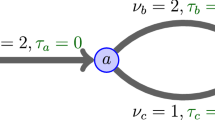Abstract
This paper presents and solves the maximum throughput dynamic network flow problem, an infinite horizon integer programming problem which involves network flows evolving over time. The model is a finite network in which the flow on each arc not only has an associated upper and lower bound but also an associated transit time. Flow is to be sent through the network in each period so as to satisfy the upper and lower bounds and conservation of flow at each node from some fixed period on. The objective is to maximize the throughput, the net flow circulating in the network in a given period, and this throughput is shown to be the same in each period. We demonstrate that among those flows with maximum throughput there is a flow which repeats every period. Moreover, a duality result shows the maximum throughput equals the minimum capacity of an appropriately defined cut.
A special case of the maximum dynamic network flow problem is the problem of minimizing the number of vehicles to meet a fixed periodic schedule. Moreover, the elegantsolution derived by Ford and Fulkerson for the finite horizon maximum dynamic flow problem may be viewed as a special case of the infinite horizon maximum dynamic flow problem and the optimality of solutions which repeat every period.
Similar content being viewed by others
References
T.E. Bartlett, “An algorithm for the minimum number of transport units to maintain a fixed schedule”,Naval Research Logistics Quarterly 4 (1957) 139–149.
T.E. Bartlett and A. Charnes, “Cyclic scheduling and combinatorial topology: assignment and routing of motive power to meet scheduling and maintenance requirements. Part II: generalization and analysis”,Naval Research Logistics Quarterly 4 (1957) 207–220.
G.B. Dantzig and D.R. Fulkerson, “Minimizing the number of tankers to meet a fixed schedule”,Naval Research Logistics Quarterly 1 (1954) 217–222.
G.B. Dantzig, Consulting work for United Airlines (1962).
J. Edmonds and R.M. Karp, “Theoretical improvements in algorithmic efficiency for network flow problems”,Journal of the Association of Computing Machinery 19 (1972) 248–264.
J. Folkman and D.R. Fulkerson, “Flows in infinite graphs”,Journal of Combinatorial Theory 8 (1970) 30–44.
L.R. Ford and D.R. Fulkerson, “Maximum flow through a network”,Canadian Journal Mathematics 8 (1956) 399–404.
L.R. Ford and D.R. Fulkerson, “Constructing maximal dynamic flows from static flows”,Operations Research 6 (1958) 419–433.
L.R. Ford and D.R. Fulkerson,Flows in networks (Princeton University Press, Princeton, NJ, 1962).
D. Gale, “Transient flows in networks”,Michigan Mathematical Journal 6 (1959) 59–63.
M.R. Garey and D.S. Johnson,Computers and intractibility: a guide to the theory of NP-completeness (W.H. Freeman and Co., San Francisco, 1979).
F. Glover, D. Klingman and C. McMillan, “The netform concept: a more effective model form and solution procedure for large scale non-linear problems”, Management Science Report No. 77-4, Graduate School of Business Administration, University of Colorado (Boulder, CO, 1977).
R.M. Karp, “Reducibility among combinatorial problems”, in: R.E. Miller and J.W. Thatcher, eds.,Complexity of Computer Computations (Plenum Press, New York, 1972) pp. 85–103.
E.L. Lawler,Combinatorial optimization: networks and matroids (Holt, Rinehart and Winston, New York, 1976).
W.L. Maxwell and R.C. Wilson, “Analysis of dynamic material handling systems by network flow”, Working Paper No. 4, Department of Industrial Operations Engineering, University of Michigan (Ann Arbor, Michigan, 1978).
E. Minieka, “Maximal lexicographic and dynamic network flows”,Operations Research 21 (1973) 517–527.
J.B. Orlin, “Dynamic convex programming,” Chapter II, Ph.D. dissertation, Department of Operations Research, Stanford University (Stanford, CA, 1981).
J.B. Orlin, “Minimum-convex-cost dynamic network flows, Chapter IV”, Ph.D. dissertation, Department of Operations Research, Stanford University (Stanford, CA, 1981).
J.B. Orlin, “Minimizing the number of vehicles to meet a fixed periodic schedule: An application of periodic posets”,Operations Research 30 (1982) 760–776.
R.W. Simpson, “Scheduling and routing models for airline systems”, Report FTL-R68-3, Department of Aeronautics and Astronautics, M.I.T. (Cambridge, MA, 1969) pp. 100–107 and 128–134.
R.D. Wollmer, “An airline schedule tail routing algorithm”, presented at the ORSA/TIMS Conference (Colorado Springs, CO, 1980).
Author information
Authors and Affiliations
Rights and permissions
About this article
Cite this article
Orlin, J.B. Maximum-throughput dynamic network flows. Mathematical Programming 27, 214–231 (1983). https://doi.org/10.1007/BF02591946
Received:
Revised:
Issue Date:
DOI: https://doi.org/10.1007/BF02591946




